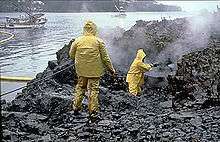Pollutant release and transfer register
Pollutant release and transfer registers (PRTRs) are systems to collect and disseminate information on environmental releases and transfers of toxic chemicals from industrial and other facilities.
They were established in several countries after the 1984 Bhopal Disaster, and the 1992 United Nations Conference on Environment and Development in Rio de Janeiro, which affirmed the "right-to-know" of communities and workers about toxics chemicals and other substances of concern.
PRTRs and Community Right to Know
In many countries industrial facilities need a permit to operate processes that are causing environmental pressures. Authorities have to balance the interests of different actors when issuing such permits and will reflect this balance in the conditions and requirements put down in the permit. Companies and civilians living near to the facilities generally have quite different levels of understanding and information on the processes and the environmental impact. In a democratic context however a level playing field for all actors involved in permitting decisions is paramount to acceptance of the decisions. Against this background, the Aarhus Convention requires the parties to this convention to set up PRTRs as a tool to provide the general public this type of information UNECE (2003) Protocol on Pollutant Release and Transfer Registers.
The European Union is a party to the UNECE Protocol on PRTRs and created its own register, the European Pollutant Release and Transfer Register (E-PRTR). This register was established by Regulation (EC) No. 166/2006[1].
PRTR data quality
PRTRs are a type of emission inventories, typically containing data on emissions to the environment from individual industrial facilities. Data collection methods for individual facility emission data in PRTRs typically consist of questionnaires, sent to individual facilities or industries. The answers are validated upon receipt by the competent authorities and published on a public web site.
In accordance with the ideas of Community right to Know, this procedure ensures that data are published as soon as they are available. Despite the validation by competent authorities, the data remain essentially the facilities' estimates and data quality control essentially depends on data users asking questions. Since facilities are by definitions only a part of all activities in a country, the sum of the emissions reported in a PRTR should for each pollutant be less or equal to the total emissions reported in national inventories.
Examples
PRTRs include those of
- Australia National pollutant inventory (NPI),
- Canada National Pollutant Release Inventory (NPRI),
- European Pollutant Release and Transfer Register (E-PRTR).
- Mexico Registro de Emisiones y Transferencia de Contaminantes (RETC),
- US Toxics Release Inventory (TRI),
Footnotes
- ↑ "EUR-Lex - 32006R0166 - EN - EUR-Lex". eur-lex.europa.eu. Retrieved 2017-03-06.
References
External links
Further reading
- "What is a PRTR?" (United Nations Institute for Training and Research)
- "What is a PRTR? (Organisation for Economic Co-operation and Development)
- "Background: PRTRs and Their Purposes" (United Nations Environment Program)
National PRTR websites:
- US Toxics Release Inventory
- Canadian National Pollutant Release Inventory
- Mexican Registro de Emisiones y Transferencia de Contaminantes
- Australian National Pollutant Inventory
- Japan PRTR
- Swedish Pollutant Release and Transfer Register
Regional PRTR websites
- European Pollutant Emissions Register
- North American Commission for Environmental Cooperation Pollutant Release and Transfer Registers (PRTR) page
PRTR Resources
- Centre for PRTR Data (OECD)
- Resource Centre for PRTR Release Estimation Techniques (OECD)
- PRTR Virtual Classroom (UNITAR)
- PRTR Capacity Building Library (UNITAR)
- NPRI Toolbox for Reporting Facilities (Canada)
Non-Governmental Organizations
- Pollutant Release Report (Active Canadian Pollution Information Site)
- Scorecard (US Pollution Information Site)
- Right-to-Know Network (US)
- PollutionWatch (Canadian Pollution Information Site-ARCHIVED)
